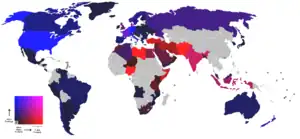The Jyllands-Posten Muhammad cartoons controversy began after twelve editorial cartoons, most of which depicted the Islamic prophet Muhammad, were published in the Danish newspaper Jyllands-Posten on 30 September 2005. The newspaper announced that this publication was an attempt to contribute to the debate regarding criticism of Islam and self-censorship. Danish Muslim organizations, who objected to the depictions, responded by holding public protests attempting to raise awareness of Jyllands-Posten's publication. The controversy deepened when further examples of the cartoons were reprinted in newspapers in more than fifty other countries. This led to protests across the Muslim world, some of which escalated into violence with police firing on the crowds (resulting in more than 100 deaths, altogether), including setting fire to the Norwegian and Danish Embassies in Syria, storming European buildings, and desecrating the Danish, Norwegian and German flags in Gaza City. While a number of Muslim leaders called for protesters to remain peaceful, other Muslim leaders across the globe, including Mahmoud al-Zahar of Hamas, issued death threats. Various groups, primarily in the Western world, responded by endorsing the Danish policies, including "Buy Danish" campaigns and other displays of support for free speech in Denmark. Danish Prime Minister Anders Fogh Rasmussen described the controversy as Denmark's worst international crisis since World War II.
< Portal:Islam < Selected article 
This article is issued from Wikipedia. The text is licensed under Creative Commons - Attribution - Sharealike. Additional terms may apply for the media files.